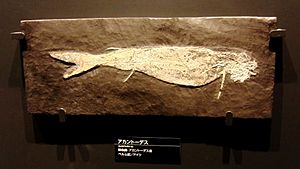Acanthodes facts for kids
Quick facts for kids Acanthodes |
|
|---|---|
 |
|
| Acanthodes bronni from the Early Permian of Germany | |
| Scientific classification | |
| Kingdom: | |
| Phylum: | |
| Class: | |
| Order: |
Acanthodiformes
|
| Family: |
Acanthodidae
|
| Genus: |
Acanthodes
|
| Species | |
|
|
Acanthodes (say "uh-KAN-thoh-deez") was an extinct type of fish, often called a "spiny shark." Its name means "spiny base" or "thorny base," which makes sense because of its sharp spines. Even though it's called a spiny shark, it's not a true shark like the ones we know today. Scientists have found fossils of Acanthodes in many places, including Europe, North America, and Australia.
Contents
What Was Acanthodes Like?
Compared to other spiny sharks, Acanthodes was quite big. It could grow up to about 30 centimeters (12 inches) long. This ancient fish did not have any teeth. Instead, it had gills that it likely used to filter tiny bits of food from the water. This means it was probably a filter feeder, eating plankton and other small particles.
Body Features and Spines
Acanthodes had a body covered in small, cube-shaped scales. It also had fewer spines than many of its relatives. It had a spine on each of its paired pectoral and pelvic fins. It also had a spine on its single anal and dorsal fins. This means it only had six spines in total, which is much less than many other spiny fish from its time.
Did Acanthodes See in Color?
In 2014, scientists found a very special fossil of Acanthodes bridgei near Hamilton, Kansas. This fossil was so well-preserved that it still had traces of its eye tissue! From this, researchers learned that Acanthodes had both rod and cone photoreceptor cells in its eyes. This is important because it means Acanthodes could probably see in color, just like humans and many other animals today.
How Do We Know About Acanthodes?
Many Acanthodes fossils have been found in an old quarry called Hamilton Quarry. These fossils show fish of different sizes, from very small to larger ones. A. bridgei was one of the species found there. This species had large eyes, a shorter area in front of its pectoral fins, and its fin spines were not deeply set into its body.
Acanthodes and Fish Family Trees
Scientists are still debating exactly where acanthodians, like Acanthodes, fit into the fish family tree. This is because they share features with both bony fish and cartilaginous fish (like sharks and rays).
A Link to Early Fish Evolution
Some recent studies suggest that Acanthodes might have been an early ancestor, or closely related to an ancestor, of all cartilaginous and bony fish. This includes even humans! This makes Acanthodes a very important fossil for understanding how fish, and even humans, evolved.
Studying the Braincase
Most of what we know about the inside of acanthodians comes from Acanthodes bronni. This is because it's the only example preserved in great detail, especially its braincase. The braincase is the part of the skull that protects the brain. Studying its braincase helps scientists understand how the skulls of early fish changed over time.
Scientists have compared 138 different features of A. bronni skulls with those of both cartilaginous and bony fish. They found that acanthodians are actually closer to cartilaginous fish. A. bronni lived about 290 million years ago, during the Carboniferous period.
Images for kids


